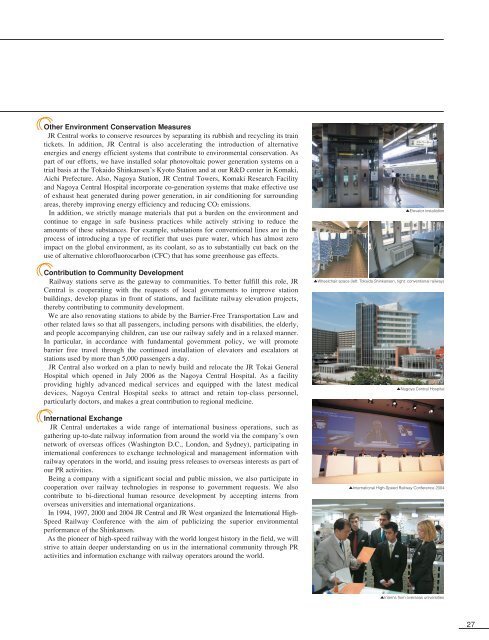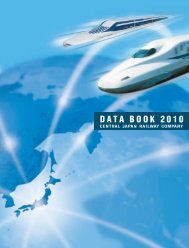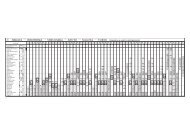CENTRAL JAPAN RAILWAY COMPANY Annual Report 2007
CENTRAL JAPAN RAILWAY COMPANY Annual Report 2007
CENTRAL JAPAN RAILWAY COMPANY Annual Report 2007
You also want an ePaper? Increase the reach of your titles
YUMPU automatically turns print PDFs into web optimized ePapers that Google loves.
Other Environment Conservation Measures<br />
JR Central works to conserve resources by separating its rubbish and recycling its train<br />
tickets. In addition, JR Central is also accelerating the introduction of alternative<br />
energies and energy efficient systems that contribute to environmental conservation. As<br />
part of our efforts, we have installed solar photovoltaic power generation systems on a<br />
trial basis at the Tokaido Shinkansen’s Kyoto Station and at our R&D center in Komaki,<br />
Aichi Prefecture. Also, Nagoya Station, JR Central Towers, Komaki Research Facility<br />
and Nagoya Central Hospital incorporate co-generation systems that make effective use<br />
of exhaust heat generated during power generation, in air conditioning for surrounding<br />
areas, thereby improving energy efficiency and reducing CO2 emissions.<br />
In addition, we strictly manage materials that put a burden on the environment and<br />
continue to engage in safe business practices while actively striving to reduce the<br />
amounts of these substances. For example, substations for conventional lines are in the<br />
process of introducing a type of rectifier that uses pure water, which has almost zero<br />
impact on the global environment, as its coolant, so as to substantially cut back on the<br />
use of alternative chlorofluorocarbon (CFC) that has some greenhouse gas effects.<br />
Elevator installation<br />
Contribution to Community Development<br />
Railway stations serve as the gateway to communities. To better fulfill this role, JR<br />
Central is cooperating with the requests of local governments to improve station<br />
buildings, develop plazas in front of stations, and facilitate railway elevation projects,<br />
thereby contributing to community development.<br />
We are also renovating stations to abide by the Barrier-Free Transportation Law and<br />
other related laws so that all passengers, including persons with disabilities, the elderly,<br />
and people accompanying children, can use our railway safely and in a relaxed manner.<br />
In particular, in accordance with fundamental government policy, we will promote<br />
barrier free travel through the continued installation of elevators and escalators at<br />
stations used by more than 5,000 passengers a day.<br />
JR Central also worked on a plan to newly build and relocate the JR Tokai General<br />
Hospital which opened in July 2006 as the Nagoya Central Hospital. As a facility<br />
providing highly advanced medical services and equipped with the latest medical<br />
devices, Nagoya Central Hospital seeks to attract and retain top-class personnel,<br />
particularly doctors, and makes a great contribution to regional medicine.<br />
Wheelchair space (left: Tokaido Shinkansen, right: conventional railway)<br />
Nagoya Central Hospital<br />
International Exchange<br />
JR Central undertakes a wide range of international business operations, such as<br />
gathering up-to-date railway information from around the world via the company’s own<br />
network of overseas offices (Washington D.C., London, and Sydney), participating in<br />
international conferences to exchange technological and management information with<br />
railway operators in the world, and issuing press releases to overseas interests as part of<br />
our PR activities.<br />
Being a company with a significant social and public mission, we also participate in<br />
cooperation over railway technologies in response to government requests. We also<br />
contribute to bi-directional human resource development by accepting interns from<br />
overseas universities and international organizations.<br />
In 1994, 1997, 2000 and 2004 JR Central and JR West organized the International High-<br />
Speed Railway Conference with the aim of publicizing the superior environmental<br />
performance of the Shinkansen.<br />
As the pioneer of high-speed railway with the world longest history in the field, we will<br />
strive to attain deeper understanding on us in the international community through PR<br />
activities and information exchange with railway operators around the world.<br />
International High-Speed Railway Conference 2004<br />
Interns from overseas universities<br />
27





